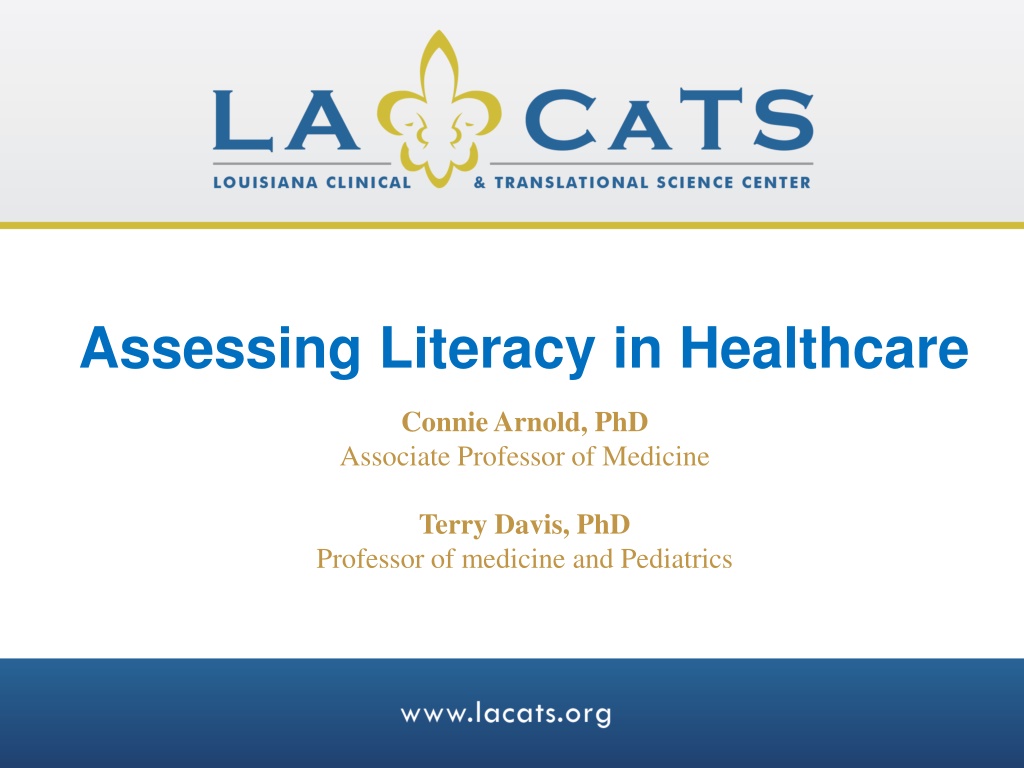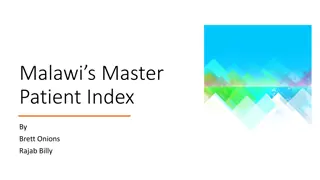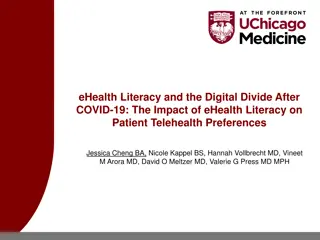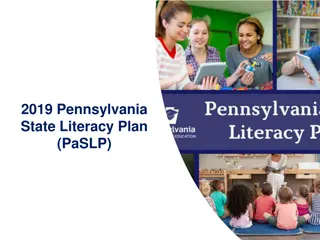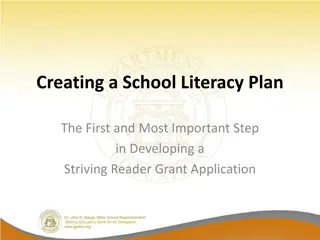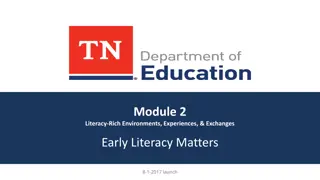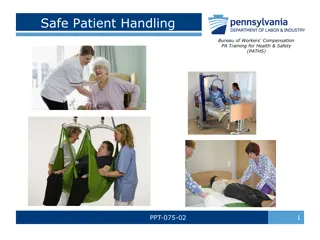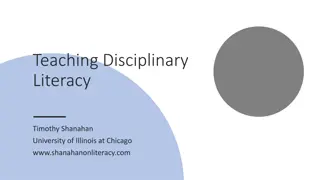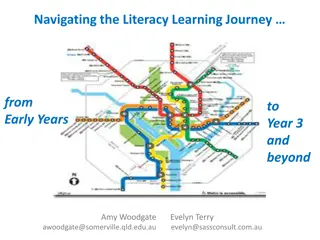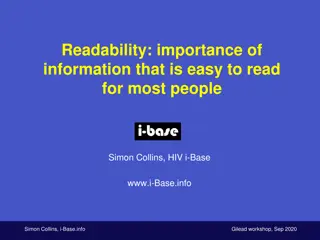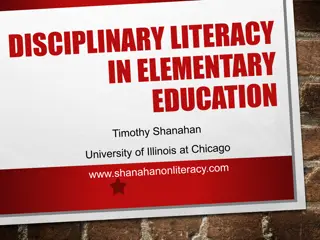Understanding Patient Literacy in Healthcare
Assessing literacy in healthcare is crucial as it can be a barrier for patients in understanding medical instructions and information. Patient literacy is not always apparent, and formal assessments are needed to measure health literacy accurately. Using tests like REALM, TOFHLA, and NVS can help healthcare providers understand patients' literacy levels and ensure information is communicated effectively. Universal precautions, such as using plain language, are recommended to enhance patient understanding and improve outcomes.
- Patient Literacy
- Healthcare Literacy
- Health Literacy Testing
- Literacy Assessment
- Health Information.
Download Presentation

Please find below an Image/Link to download the presentation.
The content on the website is provided AS IS for your information and personal use only. It may not be sold, licensed, or shared on other websites without obtaining consent from the author. Download presentation by click this link. If you encounter any issues during the download, it is possible that the publisher has removed the file from their server.
E N D
Presentation Transcript
Assessing Literacy in Healthcare Connie Arnold, PhD Associate Professor of Medicine Terry Davis, PhD Professor of medicine and Pediatrics
Patient Literacy Why Assess Patient Literacy? Literacy can be a barrier to patient s ability to understand and act on instructions, forms and surveys People will NOT tell you if they cannot read well You CANNOT tell just by looking at a person Years of schooling is NOT a good measure of literacy level Reading comprehension may be 2 to 5 grade levels < education level In research, literacy is an easy, yet informative variable to add
Patient Literacy How do I Measure Health Literacy? Several tests measure literacy in healthcare research Some have math sections All existing tests measure literacy in health context (i.e. not health literacy) These formal assessments provide a proxy measure of health literacy Can be used to compare results in the literature Patient s score on literacy test is an indication they may struggle to understand and act on oral or written health information
Patient Literacy What You Need to Know About Assessing Health Literacy Testing patient literacy level alone will NOT confirm ability to navigate, act, understand, and act on health information and manage care To get the most accurate measure of health literacy, use teach back method on patient s need to know and do or measure knowledge, beliefs, behavior and self-efficacy No evidence that literacy testing improves health care delivery or outcomes when testing is done strictly for clinical use Universal precautions (plain language) are recommended to make materials user-friendly
Literacy Testing Literacy Tests Used in Healthcare Several literacy tests have been used in healthcare research The 3 most commonly used tests are: REALM Rapid Estimate of Literacy Medicine TOFHLA Test of Functional Health Literacy NVS Newest Vital Sign These are sometimes referred to as tests of health literacy
Literacy Testing Considerations in Selecting Tests Reports in literature Validity/Reliability Cost Training required Ease of administration & scoring Time required Age and language of patients Enlarged print versions available
Literacy Testing Literacy Tests Cited in Literature Many are now referred to as HL tests TEST YEAR TYPE REALM 91, 93 Health word recognition TOFHLA* 95 Comprehension of health materials TOFHLA-S Spanish version STOFHLA 99 Comprehension of two health forms N.V.S. 05 Comprehension, numeracy interpretation food label REALM-R 03 Health word recognition (11 words) REALM-SF 06 Health word recognition (7 words) SAHLSA 07 Spanish word recognition and comprehension
REALM What is REALM? A 66 item word recognition test composed of common health words Available in English only Highly correlated with: WRAT (.88) PIAT (.97) SORT (.96) TOFHLA (.84) Time to administer test: ~ 2 minutes Translates into three grade levels: 6th grade (low literacy) 7-8th grade (marginal literacy) 9th grade (adequate literacy) Davis 1993, Fam Med
List 1 List 2 List 3 fat fatigue allergic flu pelvic menstrual pill jaundice testicle dose infection colitis eye exercise emergency stress behavior medication smear prescription occupation nerves notify sexually germs gallbladder alcoholism meals calories irritation disease depression constipation cancer miscarriage gonorrhea caffeine pregnancy inflammatory attack arthritis diabetes kidney nutrition hepatitis hormones menopause antibiotics herpes appendix diagnosis seizure abnormal potassium bowel syphilis anemia asthma hemorrhoids obesity rectal nausea osteoporosis incest directed impetigo
REALM Commonly Asked Questions About the REALM Pronunciation of endings must be 100% accurate Accent Use your judgment Language other than English Not proven in other languages Do I need permission to use? No, it is in the public domain. It costs $65 for the manual (free for LACaTS members)
Short REALMs: REALM-R REAL-R (2002) Correlations: REALM (.72), WRAT-R3 (.64) Score of 6 = risk for low literacy 11 words (only 8 are scored) fat, flu, and pill are not scored Fat Fatigue Flu Directed Pull Colitis Allergic Constipation Jaundice Osteoporosis Anemia
Short REALMs: REALM-SF REAL-SF (2007) Correlations: REALM (.94), WRAT-R3 (.83) Score: 0 3 4 6 6th grade (low literacy) 7-8th grade (marginal literacy) 7 9th grade (adequate literacy) 7 words Menopause Antibiotics Exercise Jaundice Rectal Anemia Behavior
TOFHLA What is TOFHLA? 3 reading comprehension sections (Cloze technique) 1 numeracy section Available in English and Spanish Correlations: WRAT (0.74) REALM (0.84) Long and short versions are available Time to administer TOFHLA: 22 minutes S-TOFHLA: 7 minutes Parker 1995, J Intern Med
TOFHLA TOFHLA Translates into three categories Inadequate functional health literacy Marginal functional health literacy Adequate functional health literacy Parker 1995, J Intern Med
STOFHLA PASSAGE A Your doctor has sent you to have a ____________ X-ray. a. stomach b. diabetes c. stitches d. germs You must have an __________ stomach when you come for ______. a. asthma b. empty c. incest d. anemia a. is. b. am. c. if. d. it. Baker 1999, Patient Ed and Couns
STOFHLA PASSAGE A CONT D The X-ray will ________ from 1 to 3 _________ to do. a. take b. view c. talk d. look a. beds b. brains c. hours d. diets THE DAY BEFORE THE X-RAY. For supper have only a ________ snack of fruit, ________ and jelly, with coffee or tea. a. little b. broth c. attack d. nausea a. toes b. throat c. toast d. thigh Baker 1999, Patient Ed and Couns
TOFHLA-S (Spanish) Lectura A Su doctor le ha ____________ a sacarse Rayos X del ______________. a. distinguido b. mandado c. corrido d. formalmente a. est mago b. caminar c. vestido d. comunmente Cuando venga por los ___________ debe de tener el est mago ___________. a. libros b. fiel c. rayos x d. dormir a. volar b. cabeza c. vac o d. contento Parker 1995, J Intern Med
TOFHLA-S (Spanish) Lectura A Este examen de Rayos X _____________ de 1 a 3 ____________. a. durar b. cantar c. permanente c. rayos x d. silla a. millas b. luz d. horas El d a antes de ____________ radiograf a, cene solamente alguna a. del b. alguna c. la d. bot n Parker 1995, J Intern Med
NVS Newest Vital Sign 6 question ice-cream nutrition label test General literacy test & numeracy skills test Moderate correlation with: REALM (0.41) TOFHLA (0.61) Available in English and Spanish Time to administer test: 5 7 minutes Translates into 3 levels: inadequate, marginal, or adequate literacy Weiss 2005, Ann Fam Med
NVS Example If you are allowed to eat 60g of carbohydrates as a snack how much ice cream could you have? Score Give 1 point for each correct answer 0 1 Inadequate Literacy 2 3 Marginal Literacy 4 6 Adequate Literacy
Qualitative Assessment Year Type 3 questions* 04 Self Report 1 question 08 Self Report How confident are you in filling out medical forms by yourself? Extremely 4 Quite a lot 3 Somewhat 2 A little bit 1 Not at all 0 Highly correlated with REALM (.72 - .84) & S-TOFHLA (.66-.74) Self-report not more predictive than demographics (age, race, education) Score 2 = limited health literacy Chew 2008, JGIM; Morris 2006, BMC Family Practice
Advantages & Disadvantages REALM TOFHLA NVS Chew Age Range > 18 years Adults only Adults only Adults only Quick, non- threatening; large font size available Measures comprehension; available in short and very short forms and in Spanish Includes numeracy interpretation; May be best with college grads Quick, non- threatening; Can be given over phone Advantages Does not discriminate above 9th grade; gives grade range estimates, not specific grade Long versions that include numeracy test are time consuming Limited use in literature Self-report Limitations
Considerations Considerations BEFORE Testing General How will you use the results? Who will give the test? When and where? Confidentiality (will score be in chart?) Patient Vision/Hearing Cognitive function Does the patient feel ill? Timing (did patient just receive bad news?)
Considerations Be Prepared What will you say to patients to explain what you re doing? What will you say if a patient asks how they are doing during or after the test? Practice giving the test before actually using it Be sure medical assistant or clerk has the adequate skills to administer
Considerations Be Sensitive to Patient s Shame Most adults and students with low literacy feel ashamed and try to hide it Testing may force exposure expose vulnerability Non-verbal communication: What is your body language, facial expression, and voice tome communicating during and after the test?
Cautions Developers of commonly used tests Recommend that testing be limited to research or for testing clinical populations to develop appropriate materials Do not recommend testing patients clinically UNLESS providers are willing to alter communication and education based on findings
Patient Testing Testing in Healthcare Bottom Lines Assessment of patient literacy in health care settings is an emerging field current instruments are 1st steps Patient s score on literacy test is an indication they may struggle to understand and act on oral or written health information A patient s ability to understand and act on oral or written health information may involve processing speed, attention, memory, reasoning, numeracy, reading, verbal fluency
Tests Tests for Children & Adolescents WRAT-R Wide Range of Achievement Test Ages 5 75 REALM-Teen Rapid Estimate of Adolescent Literacy in Medicine Ages 12 - 18
WRAT-R3 What is WRAT-R3? Word recognition test spelling and arithmetic sections Available in English only 2 versions to allow pre- and post-testing Time to administer test: 3 5 minutes Difficult for low-level readers (and all of us) (assuage, terpsichorean)
WRAT-R3 Raw score gives grade equivalent: 0 12 35 36 Pre-School 5th Grade 13 18 37 38 Kindergarten 6th Grade 19 23 39 1st Grade 7th Grade 24 28 40 41 2nd Grade 8th Grade 29 31 42 47 4th Grade High School 32 34 48 57 5th Grade Post HS
WRAT-R3 A B O S E R T H U P I V Z J Q IN CAT BOOK TREE HOW ANIMAL EVEN SPELL FINGER SIZE FELT SPLIT LAME STRETCH BULK ABUSE CONTEMPORARY COLLAPSE CONTAGIOUS TRIUMPH ALCOVE BIBLIOGRAPHY HORIZON MUNICIPAL UNANIMOUS BENIGN DISCRETIONARY STRATAGEM SEISMOGRAPH HERESY ITINERARY USURP IRASCIBLE PSEUDONYM OLIGARCHY COVETOUSNESS HEINOUS EGREGIOUS OMNISCIENT ASSUAGE DISINGENUOUS TERPSICHOREAN
REALM-Teen What is REALM-Teen? 66 word recognition test Developed for adolescents age 12 18 Used words from AAP materials Highly correlated with: WRAT (.83) SORT (.93)
REALM-Teen Scoring Raw score = total number of correctly pronounced words Dictionary pronunciation is the scoring standard Raw Score 0-37 Grade Range Equivalent < 3rd Grade Literacy Skills These adolescents will have a 5 fold likelihood of reading below grade level. They may be at risk of school failure. 38-44 4th - 5th Grade 45-58 6th - 7th Grade Will struggle with most patient education materials; may have skills to pass GED. 59-62 8th - 9th Grade 63-66 > 10th Grade Will be able to read most patient education materials.
Ordering Information REALM and REALM-Teen tdavis1@lsuhsc.edu TOFHLA, TOFHLA-Spanish and STOFHLA http://peppercornbooks.com/catalog NVS http://www.clearhealthcommunication.com/physicians-providers/newest- vital-sign.html WRAT http://www3.parinc.com/products/product.aspx
Key References Davis T, Kennen EM, Gazmararian JA, Williams MV. Literacy testing in health care research. In: Schwartzberg JG, VanGeest JB, Wang CC, eds. Understanding health literacy: Implications for medicine and public health. United States of America: AMA Press; 2005: 157-179. White S. Assessing the Nation s Health Literacy: Key concepts and findings of the National Assessment of Adult Literacy (NAAL). AMA Foundation, 2008.
Original Citations REALM Davis TC, et al. Rapid Estimate of Adult Literacy in Medicine: A shortened screening instrument. Fam Med 1993;25(6):256-60. REALM-R Bass PF, et al. Residents' ability to identify patients with poor literacy skills. Acad Med. 2002 Oct;77(10):1039-41. REALM-SF Arozullah AM, et al. Development and validation of the Rapid Estimate of Adult Literacy in Medicine (REALM) Short Form. Medical Care. 2007; 45(11):1026-33. REALM-Teen Davis TC, et al. Development and validation of the Rapid Estimate of Adolescent Literacy in Medicine (REALM) Teen: A tool to screen adolescents for below-grade reading in health care settings. Pediatrics. 2006; 118:1707-14.
Original Citations Contd NVS Weiss BD, et al. Quick assessment of literacy in primary care: the newest vital sign. Ann Fam Med. 2005 Nov-Dec;3(6):514-22. Qualitative Assessment Chew LD, et al. Validation of screening questions for limited health literacy in a large VA outpatient population. J Gen Intern Med. 2008 March;23(5):561-6. TOFHLA and TOFHLA-S Parker RM, et al. The test of functional health literacy in adults: a new instrument for measuring patients literacy skills. J Gen Intern Med. 1995;10:537-41. STOFHLA Baker DW, et al. Development of a brief test to measure functional health literacy. Patient Education and Counseling. 1999;38:33-42.
